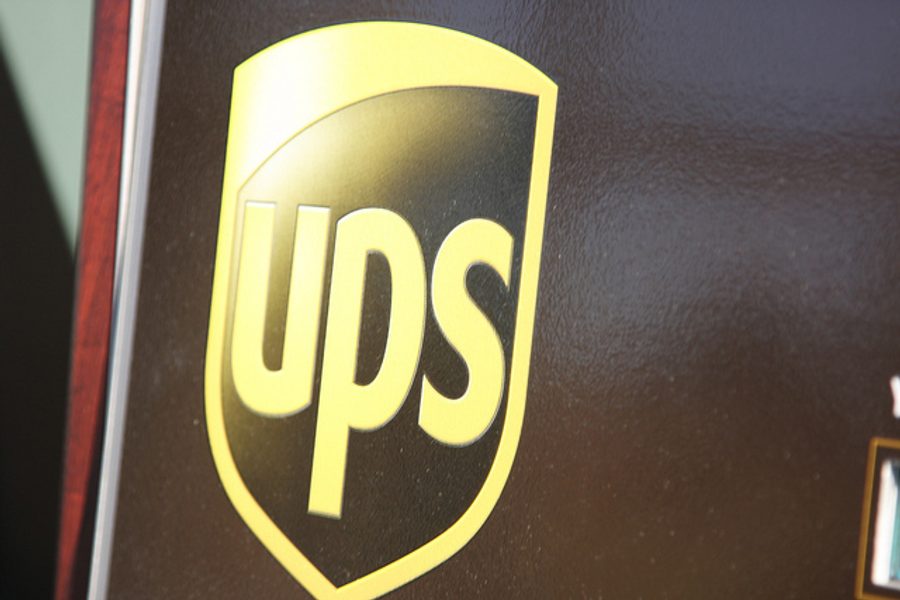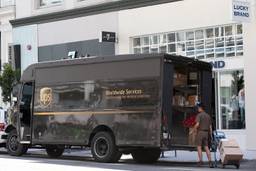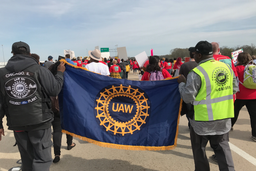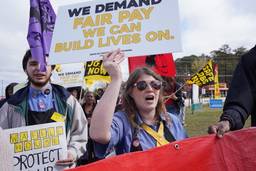This article was first posted at Socialist Worker.
Earlier this year, United Parcel Service (UPS) boasted that it was “recognized as a World’s Most Ethical Company for the 10th consecutive year by the Ethisphere Institute, a global leader in defining and advancing the standards of ethical business practices.”
UPS is one of the world’s most recognizable corporate brands, known for many decades by its familiar nickname “Big Brown” because of its familiar brown package delivery trucks. It has a global workforce of 440,000 and is one of the top 10 employers in the U.S.
Why has UPS been described as an ethical company? In a press release, Big Brown stressed that “the World’s Most Ethical Companies designation recognizes those companies that align principle with action, (and) work tirelessly to make trust part of their corporate DNA.”
But there’s something else engrained deep in UPS’s “corporate DNA”: racism. Across the U.S., UPS has singled out and systematically harassed African American workers, leading to civil right lawsuits, protests by the NAACP and, in one case, a picket against racism by a local Teamsters union.
Here are some examples of the experiences endured by people of color working for UPS:
Riviera Beach, Florida: Marvin Merritt, who has worked for UPS for three years, told a local television station about the constant abuse he endured from a former supervisor. “He’s walking right behind me, over my shoulder, harassing me.” “He shook his head, and he just called me a lazy n***** and walked away, which was so wrong.”
In March of this year, 70 of Merritt’s co-workers and fellow Teamsters rallied outside the UPS hub, protesting what they called a pattern of discrimination at the Riviera Beach hub. The offending supervisor was removed from the building, but not fired from the company.
Lexington, Kentucky: In April, a jury found UPS liable for creating a hostile workplace environment, for explicitly discriminating against one Black employee, and for retaliating against three others. “The jury awarded damages of $1.5 million to one man, $1 million to a second, and between $100,000 and $810,000 for six others, for a total of $5.3 million,” reported the Lexington Herald-Leader.
During the trial, the paper reported, “(t)estimony was heard and evidence was introduced…that an effigy of a Black UPS driver was hung from a ceiling for four days.”
Nooses, of course, are historically identified with the lynching of Black men, most commonly in Southern states. UPS’s defense of its supervisors’ actions were that it a safety demonstration.
Chapel Hill, North Carolina: The News and Observer interviewed UPS workers in Raleigh, Durham and Chapel Hill and found that “Black and Hispanic workers are common targets of abusive language and over-supervision. One longtime worker said multiple supervisors would follow him as he made his rounds, looking for violations. Another worker produced certified letters sent over a two-year period informing the worker of several discharges.”
One 28-year employee, Dianne Edwards, said she had been discharged 33 times!
In all of these cases UPS’s actions violate not only various anti-discrimination laws but the company’s national contract with the International Brotherhood of Teamsters, which represents nearly 250,000 workers at UPS across the U.S.
The National Master United Parcel Service Agreement specifically prohibits discrimination “against any individual with respect to hiring, compensation, terms or conditions of employment because of such individual’s race, color, religion, sex, sexual orientation, national origin, physical disability veteran status or age in violation of any federal or state law.” It also clearly states, “The Employer will treat employees with dignity and respect at all times.”
Yet in the midst of this epidemic of racism, UPS CEO David Abney chose last month to express pride in his “Mississippi heritage” in an interview with the BBC.
Whatever that may mean for Abney, for many of us, Mississippi’s heritage is one of bigotry, racism and extreme inequality, backed up by state violence and state-sponsored vigilante violence.
- - - - - - - - - - - - - - - -
UPS is one of the largest employers of African Americans in the U.S., especially in the big metropolitan areas. The company’s most visible Black workers are the package car or air drivers who deliver or pick up packages at homes and business, followed by the tractor-trailer drivers — called “feeder drivers” in the company lingo — on the highways.
However, the largest contingent of Black workers at UPS is among the hidden army of part-timers working all hours of the day and night in sorting facilities or hubs across the country.
The largest of these sorting facilities is the “CACH” — the Chicago Area Consolidated Hub — that straddles Chicago’s southwestern suburbs of Hodgins and Willow Springs. During the end-of-year holiday season, it can employ up to 8,000 workers. Thousands of African Americans drive or ride public transportation from Chicago’s South Side or the predominately Black Southern suburbs every day.
According to UPS’s 2015 Corporate Sustainability Report, 23 percent of the company’s U.S. employees are African American, nearly double their percentage in the U.S. population. Some 14 percent of its U.S. workforce is Latino. UPS’s figures don’t give a breakdown according to job categories, but the vast majority of African Americans work in non-supervisory positions.
UPS wasn’t always a large or even a small employer of African-Americans. In the mid-1960s, at the peak of the civil rights movement, UPS had an overwhelmingly white male workforce. Greg Niemann, a former UPS manager-turned-company historian, wrote in his otherwise fawning history Big Brown: “By a longstanding tradition many companies did not hire minorities, and UPS was one of them. UPS found it easier to go along with the majority of white America, and its managers indulged in stereotyping minorities rather than hiring them.”
A big motivating factor in changing UPS’s hiring policies was a fear of expensive lawsuits. The Equal Employment Opportunity Commission (EEOC), led by its Chair William H. Brown, a well-known Black attorney from Philadelphia, won a landmark case against corporate goliath AT&T in 1973, leading to “a very expensive consent decree,” Niemann wrote. “It was a wake-up call to American industry.”
UPS tried to put a more progressive face on the company, moving several men with reputations for being “liberal” into executive positions. Brown, the former EEOC chair, became the first African American to serve on the UPS Board of Directors in 1982.
These changes from above clearly had an impact on UPS’s hiring policies. However, many of them occurred during the 1970s, when the company was massively expanding its national workforce and would had been forced to hire outside of its traditional pool of white men in any event.
- - - - - - - - - - - - - - - -
While UPS today can claim to have a racially diverse workforce, that clearly hasn’t meant an end to racism on the job.
Today’s examples of racist abuse and retaliation are remarkably similar to events 20 years ago in Oakland, California. Black UPS drivers went to the local NAACP to ask it to investigate their complaints of bigotry and harassment.
Some 500 people, mostly UPS workers, attended a public forum where Black drivers testified for four hours that they were routinely assigned to the most dangerous routes without protection, leading to one driver being killed and four others robbed; called “boys” and “monkeys” when they returned undelivered packages; overlooked for promotions and ignored when they bid on safer routes, despite having seniority.
Timothy Mapfumo, a 14-year UPS employee, testified that a supervisor told him that “white drivers can relate to people in the (Oakland) hills better and that Black drivers can relate to people in the ghetto.”
A class action lawsuit was later filed against UPS on May 1, 1997 on behalf of African American drivers and part-timers from Oakland and beyond, as far away as San Bernandino. “Racial discrimination in this company is like humidity,” William Lewis, a driver and 23-year UPS veteran, told the media. “You can’t see it but you can feel it.”
UPS lost the suit — and while it didn’t admit guilt, it did agree to a wide-ranging settlement to be monitored by the federal court for three years. The agreement included a large monetary award for all African American part-timers who worked for UPS in the Northwest and Pacific regions from January 1996 to February 1999, as well as new procedures for posting the availability of jobs, jobs locations, monitoring of promotions and driver training.
The company paid more than $3 million in fees and costs to the plaintiffs’ attorneys and another $150,000 for future costs of monitoring the settlement. Such a humiliating defeat and the stiff price tag should have been deterrent to racist behavior. But has it been?
If William Lewis was right that racism at UPS 20 years ago was like the “humidity,” then the effigy of a black driver that hung from a ceiling for four days in Lexington is a bad sign that racism has grown more open instead.
This isn’t to say that UPS doesn’t have prominent African Americans in its management hierarchy. For example, Noel Massie, who is Black, is president for UPS’s Southern California district, which includes Hawaii and part of Nevada, where over 20,000 UPS employees work for him.
But having Black faces in high places at UPS has meant very little for the working conditions of Black drivers and hub workers.
This isn’t the exception, but the rule at U.S. companies. The last four decades have seen both a growing inequality and militarization of U.S. society and an increasingly totalitarian workplace — they are two sides of the same coin. Thus, Black communities have suffered frightening police violence while Black workers are among those — undocumented workers are another — who face the brunt of management’s wrath, scorn and abuse on the job.
This process has created worsening conditions for all workers, expressed at times in mental health issues, suicides and periodic explosions of violence. That was the case for Joe Tesney, a white UPS package car driver who shot and killed two supervisors and himself in September 2014. Tesney, a veteran at UPS, told his minister that he had been “troubled” over work. He was fired after a long period of harassment and was facing economic ruin.
- - - - - - - - - - - - - - - -
Unlike most workplaces, UPS has been unionized for more than eight decades, and its workers are overwhelmingly represented by the Teamsters. Twenty years ago, during the struggle in Oakland, UPS driver Daniel Dugar declared, “If the union had done their damn job, we wouldn’t be here now.”
So where have the Teamsters been on these issues? The sad answer is: missing in action.
For the past 17 years, the Teamsters have been led by James P. Hoffa Jr., son of the infamous Teamster leader Jimmy Hoffa who disappeared and was presumed murdered by his former Mafia friends in 1975. Hoffa Junior has shown no interest in confronting racism — or much of anything at all — at UPS, even though it is the largest employer of Teamsters in the country.
That’s no surprise given Hoffa’s inaction at other Teamster-represented companies.
For example, in 2010 and 2012, it was the Equal Employment Opportunity Commission (EEOC), not the Teamsters, that challenged workplace racism at freight giant YRC, the corporation created in the merger of Roadway and Yellow Freight in 2008. The EEOC charged that YRC and its predecessor Yellow had created a racially hostile workplace at its former Chicago Ridge and current Chicago Heights facilities.
Had the case gone to trial, the EEOC reported, the proceedings would have revealed:
evidence that Black employees were subjected to multiple incidents of hangman’s nooses and racist graffiti, comments and cartoons. The EEOC also would have presented evidence that Yellow and YRC subjected Black employees to harsher discipline and scrutiny than their white counterparts and gave them more difficult and time-consuming work assignments.
The Teamsters were absent in another case were racism took a deadly toll. In one of the most controversial mass shootings of the past decade, Omar Thornton, a Black driver and Teamster at Hartford Distributors in Manchester, Connecticut, shot and killed eight coworkers before killing himself. Thornton was accused of theft and was offered the choice of resignation. As he was leaving the building, he went on a killing spree. All his victims were white.
Thornton told the 911 operator that the massacre was motivated by racism at workplace. Thornton’s girlfriend claimed that she saw pictures, presumably taken by Thornton, of a hangman’s noose and racist graffiti on bathroom walls.
“This all could have been avoided,” Thornton’s uncle, Will Holliday, told the media. “He went to the union a couple of times with issues concerning what was going on, and it was not dealt with appropriately.”
- - - - - - - - - - - - - - - -
UPS has succeeded General Motors as the largest private-sector, unionized employer in the U.S. What happens at UPS and at other large unionized employers like YRC sets the standards not only for wages and benefits, but for dignity and respect on the job for all workers.
In a time of a growing awareness about the depths of racism in U.S. society, the Teamsters, the fourth-largest union in the country and one of the largest union representatives of African-American workers—nearly 450,000 men and women, or one-third of the union, are Black—should be in the lead confronting employer racism especially at UPS. This would require a more aggressive stance on a broad range of issues, from support for the Fight for 15 campaign to greater challenges on pension and health care concessions.
It’s hard to see that happening without a change in the national leadership of the Teamsters.
A radical change is necessary in the organization of Black workers inside the Teamsters. The longstanding Teamster National Black Caucus (TNBC) acts more like a social club than a militant advocate for one-third of the membership.
Founded in 1971, the TNBC was a pre-emptive action taken by a handful of Black officials, with the connivance of then-Teamster General President Frank Fitzsimmons, to stop the formation of something more independent and militant, like, for example, the League of Revolutionary Black Workers in the United Auto Workers. The TNBC’s founding conference wasn’t even held until four years later, after Fitzsimmons, a longtime associate of Jimmy Hoffa and organized crime, appointed an ally to be its chair.
The TNBC has always been a useless creature of the Teamster Old Guard. A new Black Lives Matter-oriented caucus is long overdue in the Teamsters union.
Having a strong union means confronting and defeating the racism that employers use against Black and Latino workers and to divide the whole workforce. It also means confronting racism among members.
We have to say to UPS and to all employers: Black Lives Matter and Union Lives Matter.








